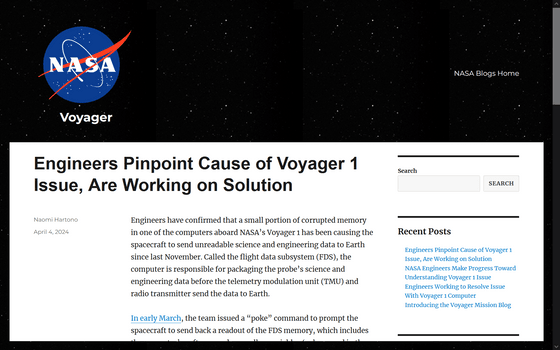The cause of the Voyager 1 malfunction that caused it to send indecipherable data for five months has been discovered

On November 14, 2023,
Engineers Pinpoint Cause of Voyager 1 Issue, Are Working on Solution – Voyager
https://blogs.nasa.gov/voyager/2024/04/04/engineers-pinpoint-cause-of-voyager-1-issue-are-working-on-solution/

NASA knows what knocked Voyager 1 offline, but it will take a while to fix | Ars Technica
Voyager 1 is a spacecraft launched in 1977 and has reached a point about 24 billion km away from Earth at the time of writing. NASA has been tracking Voyager 1 for about 45 years, but in 2023 it was confirmed that Voyager 1 was transmitting indecipherable data.

According to NASA, the data reporting the measurements and the spacecraft's operating status became unreadable, making it impossible to know the current status of Voyager 1. NASA investigated the cause and soon came to the conclusion that there may have been a problem with the Flight Data System (FDS), which packages Voyager 1's observation data and operating status.
In March 2024, the NASA team sent a command to Voyager 1 requesting it to send back the results of reading the memory that manages the FDS, and waited for the results. The data returned from Voyager 1 revealed that about 3% of the FDS's memory was corrupted, preventing the computer from operating normally.
Based on these results, the NASA team speculates that 'some of the chips responsible for storing part of the FDS memory may not be functioning. Although it may take several weeks or months, there is still hope for recovery, and NASA is looking for ways to operate the FDS without the malfunctioning chips.
It's not easy to pinpoint the cause of the malfunction, but at the time of writing, it's thought that the chip may have been hit by an energy particle from space, or that it may have deteriorated over the years.

by NASA/JPL-Caltech
In February 2024, NASA's Suzanne Dodd, project manager for the Voyager program, said of the malfunction, 'This is one of the most serious problems Voyager 1 has ever faced.' Although the FDS was revolutionary technology at the time, by 2024, nearly half a century later, it was so outdated that NASA engineers had to refer to paper documents and blueprints to understand the design.
Because Voyager 1 is so far from Earth, it takes about 22.5 hours to send and receive radio signals one way. Also, a large communications antenna must be used to communicate with Voyager 1, but this antenna is used by other space programs and cannot be exclusively used by Voyager 1. For these reasons, it may take some time to return Voyager 1 to normal operations.
Related Posts:
in Hardware, Posted by log1p_kr







